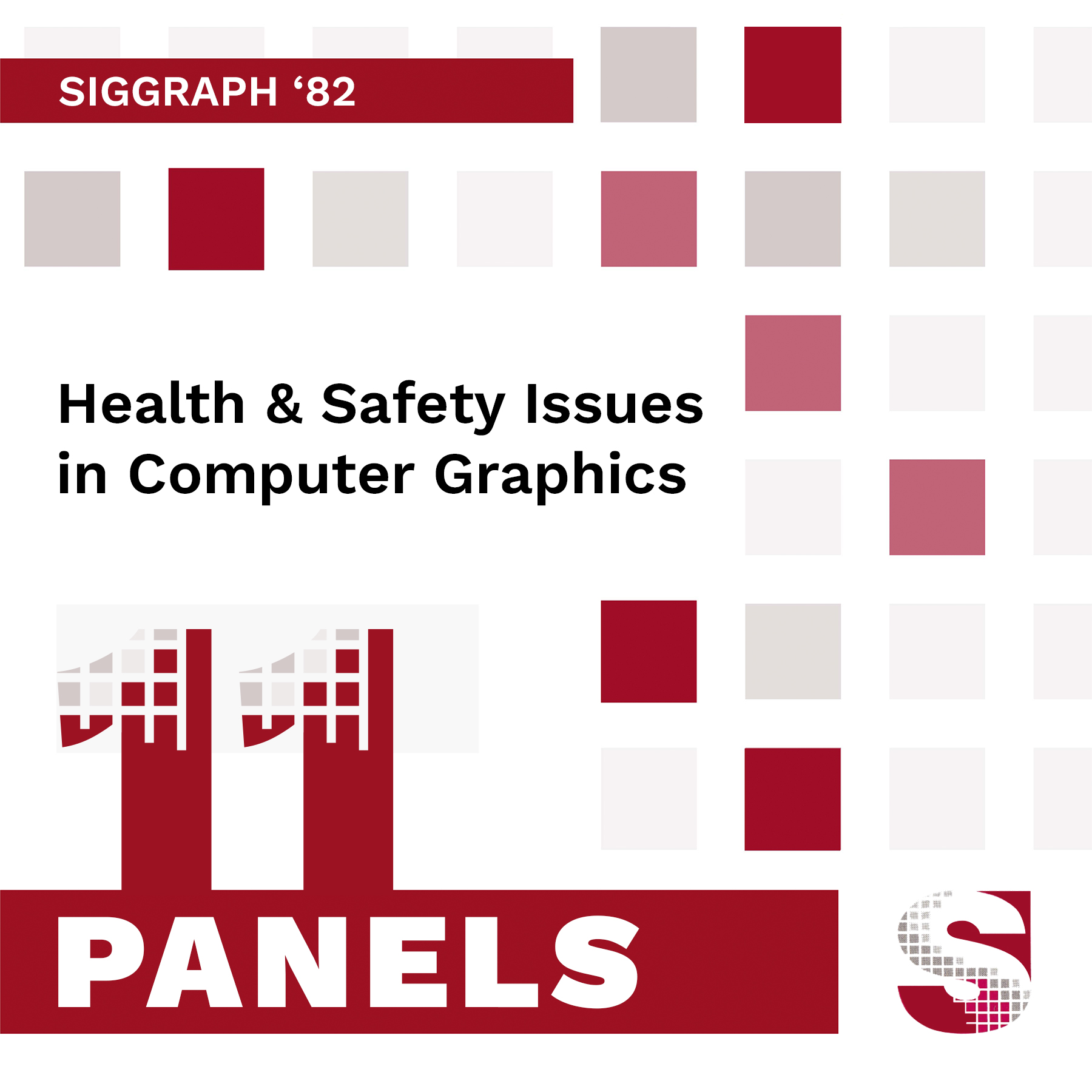“Health & safety issues in computer graphics” Moderated by
Conference:
Type(s):
Entry Number: 11
Title:
- Health & safety issues in computer graphics
Presenter(s)/Author(s):
Abstract:
Dr. Wordie Parr Dr. Parr is Chief of the Physical Agents Effects Branch of NIOSH (National Institute for Occupational Safety and Health. He is internationally known as an expert in radiation biology. Currently, Dr. Parr’s duties involve directing field and research programs in noise and electromagnetic radiation (EMR). As a result of this involvement, one of Dr. Parr’s recent activities has been centered around the issue of whether video display terminals (VDTs) pose a radiation health issue to workers in various fields. Dr. Parr and his staff at NIOSH have evaluated over 1000 different VDTs of all types, makes, and models. The results of these evaluations have all been published in the literature and will be reviewed in this session. David Sliney Mr. Sliney has been involved in standards development and in investigating potential hazards associated with lasers and conventional lightsources (including devices using cathode ray tubes and other optical display techniques). He recently co-authored a book on Optical Radiation Safety. R. C. Petersen R. C. Petersen works in the Environmental Health and Safety Department of Bell Laboratories in Murray Hill, NJ, where his responsibilities include non-ionizing radiation protection for the Bell System. This assignment includes characterizing and documenting the accessible levels of electromagnetic energy associated with existing and prototype RF and microwave transmission equipment used by the Bell System. W. M. Zuk Dr. W. M. Zuk is Head of the X-Rays Section, Consumer and Clinical Radiation Hazards Division, Health Protection Branch of Health and Welfare Canada. William H. Cushman Dr. William H. Cushman is a research psychologist and ergonomics consultant for Eastman Kodak Company in Rochester, NY. He has particular interests in visual perception, workplace design, lighting and industrial ergonomics. Optical Radiation Emissions from VDTs David Sliney Several groups of scientists in this country and overseas have measured the ultraviolet, visible and infrared radiations emitted by visual display devices to determine if potential optical radiation hazards exist from such displays. These measurements will be explained and conclusions drawn will be summarized and discussed. Radiofrequency and Microwave Emissions from VDTs R. C. Peterson Questions are continually being raised concerning potential health effects associated with exposure to radio frequency and microwave emissions from optical display devices. Because of these questions, several studies were undertaken by private and governmental organizations to characterize such emissions as a function of frequency and intensity. In particular, the band of frequencies extending from 10kHz to 18GHz was examined by Bell Laboratories for a variety of VDTs under normal conditions of operation. Similar emission measurements were made at a repair facility where a number of malfunctioning devices with their housings removed were operated simultaneously. In all cases, the sweep frequency and numerous harmonics were detected along with emissions at higher frequencies that could be associated with the digital clock or other switching equipment located within the terminal or within peripheral equipment. In no case did individual levels or the sum of all measured emissions even remotely approach exposure guidelines existing or proposed in either the United States or any other nation. The conclusion of this study, which is supported by the results of other similar studies, is that there is absolutely no evidence to indicate, nor is it even a subject of speculation, that the emissions associated with VDTs will or could have deleterious effects on the health of those persons using such devices. Measurements of X-ray Emission from VDTs W. M. Zuk The proliferation of video display terminals in the work environment has given rise to questions about possible adverse health effects associated with their use. In particular, considerable concern has been voiced by the media and labour organizations about the possibility of VDTs posing a radiation hazard to the operators of these devices. In response to this concern, a large number of reputable scientific surveys of radiation emissions from VDTs have been carried out all over the world. Collectively these surveys have encompassed virtually every make and model of VDT and have included emission measurements for x-ray, microwave, radiofrequency, ultraviolet infrared and visible radiations. The Radiation Protection Bureau of Health and Welfare Canada, in common with other health agencies, has made measurements for all of these radiations, however, this presentation will focus on the x-ray measurements only. In the past eleven years the Radiation Protection Bureau has carried out x-ray measurements on over 300 VDTs, comprising over 150 different models. In all cases no x-ray emission above instrumental background levels was detected. To assess the validity that VDTs might be emitting x-rays below levels detectable by the most commonly used field survey instruments (Victoreen 44DRF/C), 38 different models were measured in the Radiation Protection Bureau’s low-level counting facility. This facility can detect low energy x-rays at emission levels some 500,000 times lower than the regulatory limit. No x-ray emission was detected. Human Factors Issues in VDT Workplace Design William H. Cushman The design of VDT workplaces has an important effect on the performance and attitude of people working with VDTs. Lighting factors are particularly important in determining the overall ergonomics of VDT workplaces. Some lighting factors that must be considered include illumination and luminance; task lighting; minimizing glare; selection and arrangement of luminaires; indirect lighting; and screens and filters for contrast enhancement. Other important factors include terminal design, furniture design, noise levels and color use.




